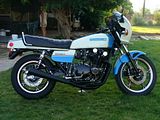Also I'm wondering how to check for a burn exhaust valve without digging into the case much deeper. In the notes the PO gave me he did a valve check 3000 miles back. But 2 of the exhaust valves are under .02mm no matter which position the lobe is in (see question above). I read where the exhaust valves can/do wear faster because of the heat. If I take the header off will I see the valves well enough to determine if they are burnt?. (and then I would need to know what a burnt valve looks like) When riding the bike right after I got it I didn't hear any backfires or terrible noises - but then again I never really listened to a GS before and I know I have a lot to learn.
Announcement
Collapse
No announcement yet.
Position of lobe on valve clearance check?
Collapse
X
-
Position of lobe on valve clearance check?
Doing my first valve check. So maybe I'm over analyzing. However I'm wondering if the point on the lobe should be perpendicular to the plane of the casting (valve cover) when checking for valve clearance or if it should be in line with the angle of the valve stem. Maybe it doesn't make any difference but I thought the shortest distance on a lobe was directly opposite the point so it seems to me that you'd want the lobe (point) at the same angle as the valve.
Also I'm wondering how to check for a burn exhaust valve without digging into the case much deeper. In the notes the PO gave me he did a valve check 3000 miles back. But 2 of the exhaust valves are under .02mm no matter which position the lobe is in (see question above). I read where the exhaust valves can/do wear faster because of the heat. If I take the header off will I see the valves well enough to determine if they are burnt?. (and then I would need to know what a burnt valve looks like) When riding the bike right after I got it I didn't hear any backfires or terrible noises - but then again I never really listened to a GS before and I know I have a lot to learn.Tags: None
-
Forum LongTimerGSResource Superstar
Past Site Supporter
Super Site Supporter- Mar 2006
- 36176
- Torrance, CA
Nothing you can do about a burned valve (other than rebuild) so don't worry about it unless the compression is poor (do a compression check after the valves are adjusted).
The valves are adjusted in pairs with the cam in a specific location; this is important so the adjacent valve is not pushing up on the cam skewing it in the journal clearance.
Exhaust valves are checked with the lobe pointing forward, parallel to the gasket surface.
Intakes are set with the lobe facing perpendicular to the gasket surface.
Exhaust lobe on #1 facing forward: check E1 and E2
Exhaust lobe on #4 facing forward: check E3 and E4
Intake lobe on #1 facing perpendicular: check I1 and I2
Intake lobe on #4 facing perpendicular: check I3 and I4
Hope this helps.Ed
To measure is to know.
Mikuni O-ring Kits For Sale...https://www.thegsresources.com/_foru...ts#post1703182
Top Newbie Mistakes thread...http://www.thegsresources.com/_forum...d.php?t=171846
Carb rebuild tutorial...https://gsarchive.bwringer.com/mtsac...d_Tutorial.pdf
KZ750E Rebuild Thread...http://www.thegsresources.com/_forum...0-Resurrection
-
After your valves are adjusted, do a compression check.Originally posted by d_hoffman View PostAlso I'm wondering how to check for a burn exhaust valve without digging into the case much deeper.
Comment
-
Nessism has it absolutely right, but let me see if I can add just a little more light, as this seems to confuse the 'new' guys.Originally posted by Nessism View PostThe valves are adjusted in pairs with the cam in a specific location; this is important so the adjacent valve is not pushing up on the cam skewing it in the journal clearance.
Exhaust valves are checked with the lobe pointing forward, parallel to the gasket surface.
Intakes are set with the lobe facing perpendicular to the gasket surface.
Exhaust lobe on #1 facing forward: check E1 and E2
Exhaust lobe on #4 facing forward: check E3 and E4
Intake lobe on #1 facing perpendicular: check I1 and I2
Intake lobe on #4 facing perpendicular: check I3 and I4
When you set #1 exhaust lobe forward, check E1 and E2 without moving the cam.
When you set #4 exhaust lobe forward, check E3 and E4 without moving the cam.
Same thing with the intake valves.
You are correct in your assumption that the lowest point on the cam is directly across from the lobe, but with our cams, that low point also extends more than 45 degrees to either side of that point. When the exhaust lobe for #1 is pointing forward, the lobe for #2 is pointing UP, and now both of them are not pushing on a valve. This removes any pushing loads from this half of the cam, assuring a known position in the cam bearing for reference.sigpic
mine: 2000 Honda GoldWing GL1500SE and 1980 GS850G'K' "Junior"
hers: 1982 GS850GL - "Angel" and 1969 Suzuki T250 Scrambler
#1 son: 1986 Yamaha Venture Royale 1300 and 1982 GS650GL "Rat Bagger"
#2 son: 1980 GS1000G
Family Portrait
Siblings and Spouses
Mom's first ride
Want a copy of my valve adjust spreadsheet for your 2-valve per cylinder engine? Send me an e-mail request (not a PM)
(Click on my username in the upper-left corner for e-mail info.)
Comment
-
 d_hoffman
d_hoffman
thank you thank you - I'm glad I asked. I guess I didn't see all these details in prior posts (but then I didn't read all 100 of them...) Let me think about it and fiddle with it some today while taking measurements
Thanks again guys
Comment
-
Before you pull a shim out, spin the shim bucket by hand with the lobe in the correct position, if it won't turn there is negative clearance, the valve can't ever seal completely and you are in valve burning territory.Originally posted by d_hoffman View Postthank you thank you - I'm glad I asked. I guess I didn't see all these details in prior posts (but then I didn't read all 100 of them...) Let me think about it and fiddle with it some today while taking measurements
Thanks again guys
If it will turn, even though the clearance is less than it should be, there is still a tiny bit of clearance, you probably have not done damage.
Either way a compression check will tell you what you need to know.
If the compression is more or less OK the valves are not burnt.
Comment
-
 d_hoffman
d_hoffman
Need three shims
Even though the clearances were less than .038 (smallest gauge) on three cylinders the valves could still rotate so I don't think anything is burnt. I'll do a compression check after the new shims are put in.
You would have had a great laugh watching me fight that valve tool for an hour. I was actually thinking of taking out the exhaust cam because I could not get #3 exhaust valve to compress. I was trying to use the tool to pry down the valve, hold it down with one hand (thumb) and pick that shim out of there with tweezers in the other hand.... (what a complete newbie) Imagine my surprise when the tool rotated down and held the valve compressed and stayed in place. So now it's off to dealer to see if they'll still trade. Or Z1 to buy. When I'm done I can send the 2.80 and 2.70 shims I won't need to the GS Valve Shim Club. They're probably top heavy on the larger shims but maybe someone can use them. thanks again for all of your help. btw - how often should a person be checking these clearances?
In case you're wondering (measurements in MM):
#1 E - .07 = gtg
#2 E - < .038; has 2.80; needs 2.75
#3 E - < .038; has 2.65; needs 2.60
#4 E - .06 = gtg
#1 I - .07 = gtg
#2 I - < .038; has 2.65; needs 2.60
#3 I - < .038; has 2.70; needs 2.65
#4 I - < .038; has 2.70; needs 2.65
Comment
-
Your bike is going to run better!Originally posted by d_hoffman View PostIn case you're wondering (measurements in MM):
#1 E - .07 = gtg
#2 E - < .038; has 2.80; needs 2.75
#3 E - < .038; has 2.65; needs 2.60
#4 E - .06 = gtg
#1 I - .07 = gtg
#2 I - < .038; has 2.65; needs 2.60
#3 I - < .038; has 2.70; needs 2.65
#4 I - < .038; has 2.70; needs 2.65
Check your valves every 5000-6000 miles.
Comment
-
 Suzuki mad
Suzuki mad
No you can't.Originally posted by d_hoffman View Post.
Also I'm wondering how to check for a burn exhaust valve without digging into the case much deeper.
No you can't.Originally posted by d_hoffman View Post.
I read where the exhaust valves can/do wear faster because of the heat. If I take the header off will I see the valves well enough to determine if they are burnt?. (and then I would need to know what a burnt valve looks like)
You'd maybe see the valve stem but that would only show you a black or oily stem which wouldn't help with a burnt out valve. Performance would have to be well down and a compression test will tell you how bad or good the engine in.
Having a valve at .02mm is below tollerance so the clearnace's need doing which should be the priority. Then, you can go from there. You might find that you've sorted the problem already.
Suzuki mad.
Comment
.png)


Comment